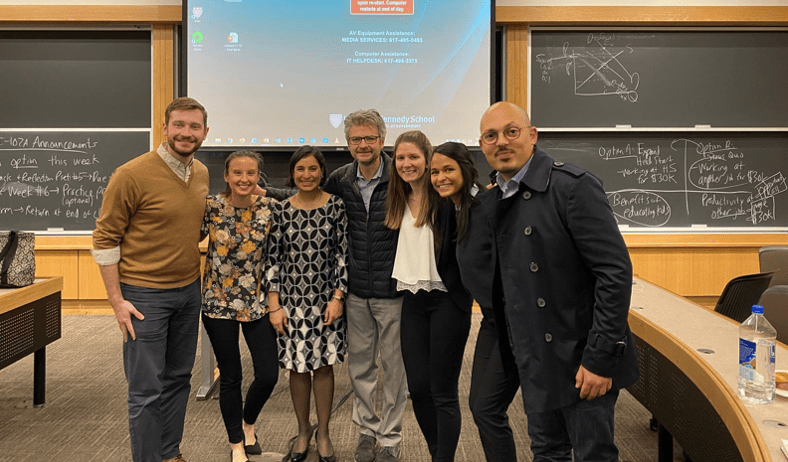Guest blog written by Nevena Bosnic, Mehdi El Boukhari, Ama Peiris, Matthew Welchert

Over the past seven weeks, our group embarked on the learning journey of problem driven iterative adaptation (PDIA) as it applies to coordination challenges facing the various levels of government as well as civil society in addressing homelessness in Tarrant County, Texas. We had the great pleasure to work with an authorizer, Maggie Jones, who serves as the Assistant Director of Tarrant County Community Development. Our team – comprised of graduate students from the Fletcher School of Law and Diplomacy at Tufts, Harvard Chan School of Public Health, Harvard Graduate School of Education, and Harvard Kennedy School of Government – provided a diversity of perspectives and richness of insights. Together, we confronted and struggled through the challenges that come with working in complex adaptive challenges as we constructed and deconstructed the problem, sought potential entry points, developed and acted on ideas for interventions, and finally, reflected and iterated with yet another round of the process. Through this blog post, we hope to share with readers: (1) our key learnings from the course, (2) insights we gained about the problem we sought to address, and (3) words of wisdom for other students and practitioners.
1. LEARNINGS FROM THE COURSE:
- The ecosystem is large and not all actors have a clear picture of how they fit within the larger system. Thus, they do not strategize well how they as an individual organization can encourage better coordination. It can be helpful to think of a metaphor of topographical map wherein your key organization is in a valley. You may see other related organizations and actors in some nearby hills and bluffs, but you might be blind to what exists beyond those heights. PDIA requires you to venture forth beyond the hills to get a sense of the total ecosystem.
- There are a lot of different stakeholders who are working independently to fight homelessness. There is little to no capitalizing on each other’s strengths because each stakeholder is bound by short term objectives and constraints. Coordination inherently requires compromising a degree of control to others, but asking organizations to share or give up some of their autonomy is a difficult ask. Constructing a problem that matters helps rally and galvanize support.
- It is alright to not have a big idea which might theoretically have a large impact. It is often better to try multiple small, achievable actions to shift towards greater change. Complexity is daunting, but by deconstructing the problem and identifying where there is sufficient authority, acceptance, and ability to act you can begin to take action. Rather than focusing all of your efforts on a big solution, removed from potential feasibility, taking immediate, fast action where possible provides lessons and begins the process of change.
- Huge challenge in understanding all of the many moving parts. Interactions and causal relationships are unlikely to reveal themselves without first pushing at the problem from multiple angles. By taking many different, small, independent actions pathways and connections might become more visible.
- The wonderful world of positive deviants. Do not reinvent the wheel. It sounds simple enough, but if you do not explore, ask around, look for the small successes already underway, then you risk missing solutions already in action.
- Deconstructing the problem is an endless process. You will always go back to redefining the problem and uncovering new root causes (rather than manifestations of the problem). Iteration can be trying, even frustrating, but the process of purposeful repetition building on what has been learned is critical to uncovering new solutions, and taking meaningful next steps.
- Un-learning’ or learning you were wrong is still learning. Through the process of iteration and adaptation, you will likely be wrong. Indeed, you should be wrong. Embrace the potential for an idea not panning out, or an action not producing the desired result. By hitting a wall, you now know there is a wall there. In dealing with complex problems, even learning the boundaries of action is an important step. But be sure to learn and adapt. Why is the wall there? Where is a backdoor? It is in asking these deeper questions that PDIA’s repetition allows us to overcome hurdles.
- Examining change space is something most people don’t think about outside of PDIA. This results in a lot of efforts being made, sometimes to no avail. Crawl around the design space; which means to explore and make use of other success being done elsewhere. Perhaps a best practice has been implemented with success elsewhere. How would it be applicable to my situation? But remember to reflect inwardly as well. There is likely a great deal of latent potential within your own organization which can be brought to bear. Change will require many kinds of actions, from both without and within.
2. INSIGHTS GAINED ABOUT COORDINATION CHALLENGES
- After we started working on the issue of lack of coordination, we learned that different stakeholders hold different perceptions of the problem. After digging deeper by asking targeted questions it appeared that some of them don’t even consider lack of coordination as being a problem in the first place.
- Hence, “Coordination” has not a one-size fits all concept. Its definition depends on the issues within the system a stakeholder is focused on, and it is quite difficult to understand what coordination should look like and how to improve what already exists.
- What you think is the problem may not be the problem. Lack of coordination might not be the root problem and can stem from a lack of a Macro perspective of: 1. how homeless people live in and navigate the system 2. To what extent different stakeholders symbiotically cooperate to alleviate the homelessness problem in the county.
3. WORDS OF WISDOM
- In the wise words of our Professor, “Embrace the art, let go of the science.” Each complex problem must be uniquely addressed, thereby requiring less technical solutions, and more creativity.
- Mutual struggle reinforces mutual learning. This is how a team transforms roadblocks into learning opportunities.
- Timely information sharing among team members is crucial. You are working both independently and as a team to tackle the adaptive challenge at hand. Timely sharing of information will help the group make progress on the topic at a swift pace.
- Engage as many people as you can, especially end users. It is critical to hear and elevate the voices of those most affected by the problem, and how they perceive the challenge. Building relationships with various individuals working with and within the system will provide a fresh perspective, and help shape your perception on the issue.
- Complex problems are deeply contextual. However, PDIA helps approach complex problems effectively even if you are not a subject matter expert.
- Break the problem down into smaller problems in order to have more areas of action. If you set a big goal, your authorizer is going to freak out when he sees that you are far from a result and might withdraw his authorization or funding.
In conclusion, this course has provided our team members with the toolkits to dive deeply and work quickly to facilitate ripples in different parts of a system. Special thanks to our authorizer (Maggie Jones), and the impeccable teaching team (Matt Andrews and Salimah Samji) for your patience, time, and commitment to helping excel our learning.
This is a blog series written by students at the Harvard Kennedy School who completed “PDIA in Action: Development Through Facilitated Emergence” (MLD 103) in March 2020. These are their learning journey stories.
